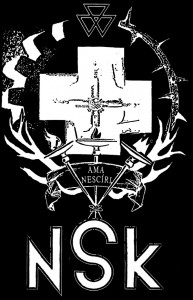Neue Slowenische Kunst
This article possibly contains original research. (May 2021) |

Neue Slowenische Kunst (Second World War. It also refers to Slovenia's previous seven centuries as part of the Habsburg monarchy.[1]
Composition
NSK was founded by the musical group
Laibach. Other NSK members include groups such as IRWIN (visual art), Scipion Nasice Sisters Theatre (also known as Red Pilot and Cosmokinetic Theatre Noordung), New Collective Studio (graphics; also known as New Collectivism), Retrovision (film and video), and the Department of Pure and Applied Philosophy (theory).[2][3][4] The founding groups of the NSK were Laibach, IRWIN, and Scipion Nasice Sisters Theater. Membership has traditionally been open to all artistic groups who show an interest in challenging the norms and taboos of Slovene national identity.[5]
Characteristics
NSK art often draws on symbols from
German eagle with a dove.[3] Intended as an ironic joke, the painting soon fell foul of the authorities, who interpreted it as equating Marshal Josip Broz Tito with Adolf Hitler. It was later reproduced on the cover of Mladina magazine, and that particular issue was subsequently banned.[6]
The NSK was the subject of a 1996 documentary film entitled Predictions of Fire (Prerokbe Ognja),[7] which was written and directed by Michael Benson. Among those interviewed is Slovenian intellectual Slavoj Žižek.
NSK State
Since 1991, the NSK has claimed to be a
consulates in several cities, including Umag, Croatia.[9] It has also issued passports and postage stamps.[10]
NSK passports are considered an art project. As such, they are not valid for travel.
In 2010, the first NSK Citizens Congress was held in Berlin. It was followed by a "NSK Rendez-Vous" in Lyon, France, where Alexei Monroe revealed NSK's aim : to make people "aware that totalitarianism isn't a discrete historical phenomenon which went on from 1933 to 1989 and then it's over so let's have a nice triumph of liberal democracy".[11] On 26 February 2011, another "NSK Rendez-Vous" took place in London. In 2012, yet another "NSK Rendez-Vous" was set to take place in New York City's Museum of Modern Art.[12]
2017 saw NSK set up a pavilion at the Venice Biennale where Slavoj Žižek stated that "the uniqueness of NSK is this idea of the 'stateless state'.[13]
See also
References
- ^ Monroe, Alexei. Interrogation Machine. MIT Press, 2005. p 3.
- ^ Anonymous. "State of Art: the new Slovene Avant Garde" (2004). Northwest Film Forum and Scala House, program for exhibit 18–24 November 2004 at Northwest Film Forum, Seattle.
- ^ a b Regina Hackett. "Slovenian art collective is adept at working politics and art". Seattle Post-Intelligencer, 19 November 2004.
- ^ "Laibach". Laibach.nsk.si. Archived from the original on 12 June 2008. Retrieved 11 June 2008.
- ^ James Gow & Cathie Carmichael, Slovenia and the Slovenes: A Small State and the New Europe, C. Hurst & Company, 2001, pp. 98-99
- ^ Gow & Carmichael, Slovenia and the Slovenes, p. 96
- ^ Holden, Steven (2 October 1996). "Facing the Menace of Totalitarianism". The New York Times. Retrieved 11 June 2008.
- ^ "[ NSKSTATE.COM ] [ The Slovenia of Athens ]". Nskstate.com. Archived from the original on 9 March 2008. Retrieved 11 June 2008.
- ^ "[ NSKSTATE.COM ]". Nskstate.com. Archived from the original on 6 April 2008. Retrieved 11 June 2008.
- ^ "[ NSKSTATE.COM ] [ HOW TO GET A PASSPORT ]". Nnskstate.com. Archived from the original on 6 April 2008. Retrieved 11 June 2008.
- ^ "NSK à Lyon : Perspektive 2/2". Archived from the original on 8 July 2011.
- ^ "NSK Passport Office, New York & NSK Rendezvous MoMA".
- ^ "A passport from a country that does not exist". BBC. 16 May 2017.
Further reading
- ISBN 961-90851-1-6.
- Arns, Inke, ed. (2003). Irwin: Retroprincip 1983-2003. Frankfurt/Main: Revolver - Archiv für aktuelle Kunst. ISBN 3-936919-56-9.
- Monroe, Alexei (2005). Interrogation Machine: Laibach and NSK. The MIT Press. ISBN 0-262-63315-9.
External links
Wikimedia Commons has media related to Neue Slowenische Kunst.
